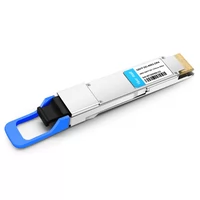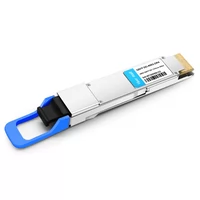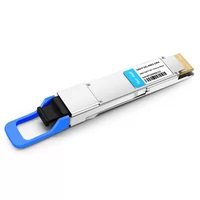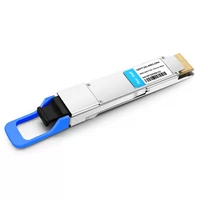The optical module is an important part of the optical communication network. It is an active optical device with a laser as the carrier and optical fiber as the transmission medium. Its core function is to realize photoelectric conversion. At present, traditional optical modules are mainly packaged by III-V semiconductor chips, high-speed circuit silicon chips, optical components, and other devices, which essentially belong to “electrical interconnection”. With the gradual reduction of transistor processing size, electrical interconnection will gradually face the transmission bottleneck, so silicon photonics technology came into being.
1. What is the silicon photonics optical transceiver?
Simply put, the silicon photonics transceiver is to integrate photoelectric conversion and transmission on a silicon chip by using silicon photonics technology. The core idea of silicon optical technology is “replacing electricity with light”, that is, using laser beam instead of an electronic signal to transmit data, and integrating optical devices and electronic components into an independent microchip.
Silicon photonics has the characteristics of low power consumption, high integration, and high rate, which is the key optical communication technology in the post-Moore era. According to Intel’s Silicon Photonics Industry Development Plan, the silicon optical module industry has entered a period of rapid development. In 2022, silicon photonics technology will comprehensively surpass traditional optical modules in terms of peak speed per second, energy consumption, and cost.
According to the data of LightCounting, a market research company, the turning point for silicon photonics technology to change the optical device industry has come. In 2025, the market scale of silicon photonics optical modules will be close to $6 billion, and the share will increase from 14% in 2018-2019 to 45% in 2025. In the next four years, the market will achieve double-digit growth.
2. What are the pros and cons of the silicon photonics optical transceiver?
Advantages of silicon photonics transceiver:
In general, silicon photonics technology has three advantages: low power consumption, high integration, and high transmission bandwidth.
- Compared with traditional discrete devices, the optical module under silicon photonics technology is based on the CMOS manufacturing process. The etching process can be used on the silicon substrate to quickly process, greatly reduce the volume, and further optimize the material cost, chip cost, and packaging cost. At the same time, silicon optical technology can conduct batch testing through wafer testing and other methods, and the testing efficiency is significantly improved.
![]()
400G DR4 Silicon Photonics optical transceiver diagram
- Silicon photonics technology uses laser beams instead of electronic signals to transmit data, and integrates optical devices and electronic components in a separate microchip, replacing copper wires with light as the information conduction medium on a silicon chip to enhance the speed of chip-to-chip connections.
- Compared to systems that transmit electrical signals over copper wires, optical communication-based systems transmit optical signals over fiber-optic lines making data faster and more efficient. Also, advanced optical modulation formats, as well as coherent detection techniques, improve spectral efficiency. The coverage of silicon-optical from the chip to local area networks (LANs) and wide-area networks (WANs) can exceed a transmission distance of 100km.
Disadvantages of silicon photonics transceiver:
Due to the large insertion loss of silicon photonics transceiver, it can maintain sufficient reliability only in short-distance transmission. Therefore, it is difficult for silicon photonics technology to realize the integration of active functional devices (light source and optical amplifier) in a short time, and there are still obstacles to large-scale commercialization.
Optical modules, especially high-speed optical modules, account for 50% ~ 60% of the cost of communication network equipment. The selection and cost of optical modules will directly affect the overall construction cost of the network. The high cost of optical modules has become a key problem hindering the development of optical communication. In the cost of the optical module, 40% is the optical chip, of which about 20% is the laser. If the laser cost is saved by 3 / 4, the overall cost can be reduced by 15%, and part of the labor and component costs can be reduced at the same time.
The main types of lasers in the optical module are VCSEL, FP, DFB, DML, and EML. Different types of lasers have different working wavelengths, modes, and application environments. At present, the technical route of optical integration commercial products is mainly divided into InP and Si. Among them, DFB, DML, EML, and other lasers are InP types. Although the technology is relatively mature, the cost is high and incompatible with the CMOS process (integrated circuit process). However, the Si type silicon optical device adopts the COMS process to realize the monolithic integration of passive optoelectronic devices and integrated circuits, which can be integrated on a large scale and has the advantages of high density and low cost. But there is a drawback – although the silicon photonics chips are compatible with CMOS processes, product yield hinders the mass-scale production of silicon photonics transceivers.
3. What are the Application Fields and Markets of the Silicon Photonics Optical Transceiver?
Among the silicon photonics optical module products currently shipped, there are two main categories: short-range data center optical modules and medium- and long-range telecom coherent optical modules. In 100G short-range CWDM4 and 100G medium- and long-range coherent optical modules, silicon optical has little cost advantage. However, in the scenario with the rate above 400G, the cost of traditional DML laser and EML laser is high, while the silicon photonics transceiver integrates optical/electrical chips such as multi-channel laser, modulator and multi-channel detector on the silicon photonics chip, which greatly reduces the volume and has obvious cost advantages. Therefore, silicon photonics technology is mostly used in 400G or even 800G transmission rates.
400G DR4 – The Basic Form of 400G Silicon Photonics Modules:
400G QSFP-DD DR4 is an optical transceiver module designed for 400G Ethernet data center interconnect in 400G QSFP-DD (Quad Small Form Factor Pluggable-double density ) form factor. On the transmitter end, this DR4 module converts 8 channels of 50Gb/s (PAM4) electrical signal into 4 channels of parallel optical output data, each capable of 100Gb/s data rate for an aggregated bandwidth of 400Gbls. On the receiver side, the optic transceiver converts 4 lanes of parallel optical data of 100Gbp/s each lane for an aggregated of 400Gbp/s to supports 8 lanes of 50Gb/s PAM4 electrical output signal.

The 400G QSFP-DD DR4 fiber module achieves the transmission over SMF(single-mode fiber) with an MPO-12 connector. It supports a max transmission distance of 500 meters on 1310nm center wavelength. The product is designed with digital diagnostic functions according to the QSFP-DD Multi-Source Agreement (MSA).
Currently, the most important application for silicon photonics products is still data centers, and 400G silicon photonics transceivers are starting to move from small-volume shipments in 2020 to high-volume shipments in 2021. The future of silicon photonics transceivers is promising.
Related Products:
-
 Cisco QDD-400G-DR4-S Compatible 400G QSFP-DD DR4 PAM4 1310nm 500m MTP/MPO SMF FEC Optical Transceiver Module
$450.00
Cisco QDD-400G-DR4-S Compatible 400G QSFP-DD DR4 PAM4 1310nm 500m MTP/MPO SMF FEC Optical Transceiver Module
$450.00
-
 QSFP-DD-400G-DR4 400G QSFP-DD DR4 PAM4 1310nm 500m MTP/MPO SMF FEC Optical Transceiver Module
$450.00
QSFP-DD-400G-DR4 400G QSFP-DD DR4 PAM4 1310nm 500m MTP/MPO SMF FEC Optical Transceiver Module
$450.00
-
 Arista Networks QDD-400G-DR4 Compatible 400G QSFP-DD DR4 PAM4 1310nm 500m MTP/MPO SMF FEC Optical Transceiver Module
$450.00
Arista Networks QDD-400G-DR4 Compatible 400G QSFP-DD DR4 PAM4 1310nm 500m MTP/MPO SMF FEC Optical Transceiver Module
$450.00
-
 Juniper Networks QDD-400G-DR4 Compatible 400G QSFP-DD DR4 PAM4 1310nm 500m MTP/MPO SMF FEC Optical Transceiver Module
$450.00
Juniper Networks QDD-400G-DR4 Compatible 400G QSFP-DD DR4 PAM4 1310nm 500m MTP/MPO SMF FEC Optical Transceiver Module
$450.00
